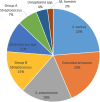PCR for the detection of pathogens in neonatal early onset sepsis
- PMID: 31978082
- PMCID: PMC6980546
- DOI: 10.1371/journal.pone.0226817
PCR for the detection of pathogens in neonatal early onset sepsis
Abstract
Background: A large proportion of neonates are treated for presumed bacterial sepsis with broad spectrum antibiotics even though their blood cultures subsequently show no growth. This study aimed to investigate PCR-based methods to identify pathogens not detected by conventional culture.
Methods: Whole blood samples of 208 neonates with suspected early onset sepsis were tested using a panel of multiplexed bacterial PCRs targeting Streptococcus pneumoniae, Streptococcus agalactiae (GBS), Staphylococcus aureus, Streptococcus pyogenes (GAS), Enterobacteriaceae, Enterococcus faecalis, Enterococcus faecium, Ureaplasma parvum, Ureaplasma urealyticum, Mycoplasma hominis and Mycoplasma genitalium, a 16S rRNA gene broad-range PCR and a multiplexed PCR for Candida spp.
Results: Two-hundred and eight samples were processed. In five of those samples, organisms were detected by conventional culture; all of those were also identified by PCR. PCR detected bacteria in 91 (45%) of the 203 samples that did not show bacterial growth in culture. S. aureus, Enterobacteriaceae and S. pneumoniae were the most frequently detected pathogens. A higher bacterial load detected by PCR was correlated positively with the number of clinical signs at presentation.
Conclusion: Real-time PCR has the potential to be a valuable additional tool for the diagnosis of neonatal sepsis.
Conflict of interest statement
The authors have declared that no competing interests exist.
Figures
References
-
- Blackburn RM, Muller-Pebody B, Planche T, Johnson A, Hopkins S, Sharland M, et al. Neonatal sepsis—many blood samples, few positive cultures: implications for improving antibiotic prescribing. Arch Dis Child Fetal Neonatal Ed. 2012; 97(6): p. F487–8. - PubMed
MeSH terms
Substances
LinkOut - more resources
Full Text Sources
Medical
Miscellaneous


